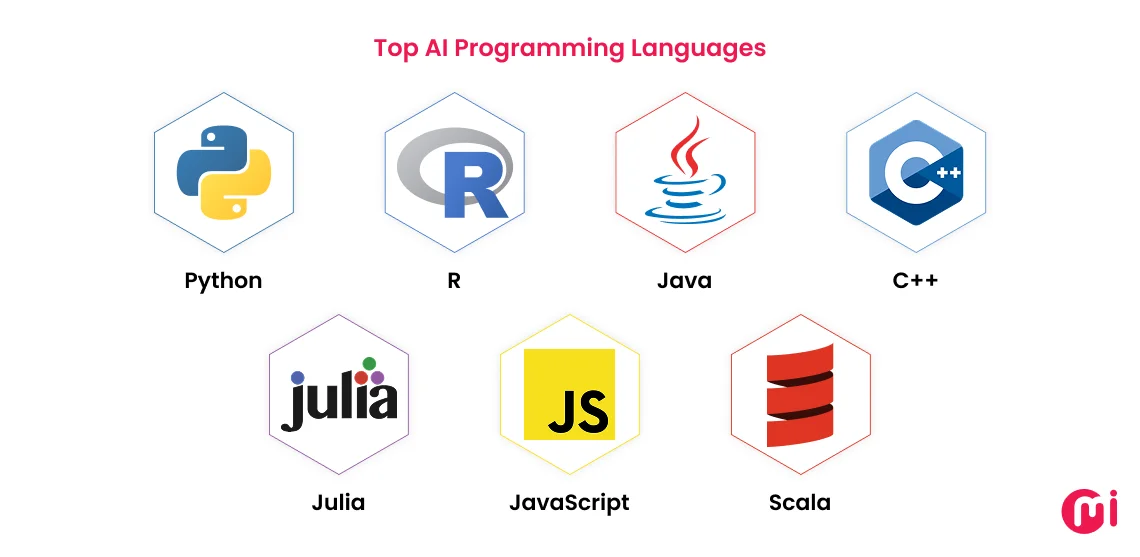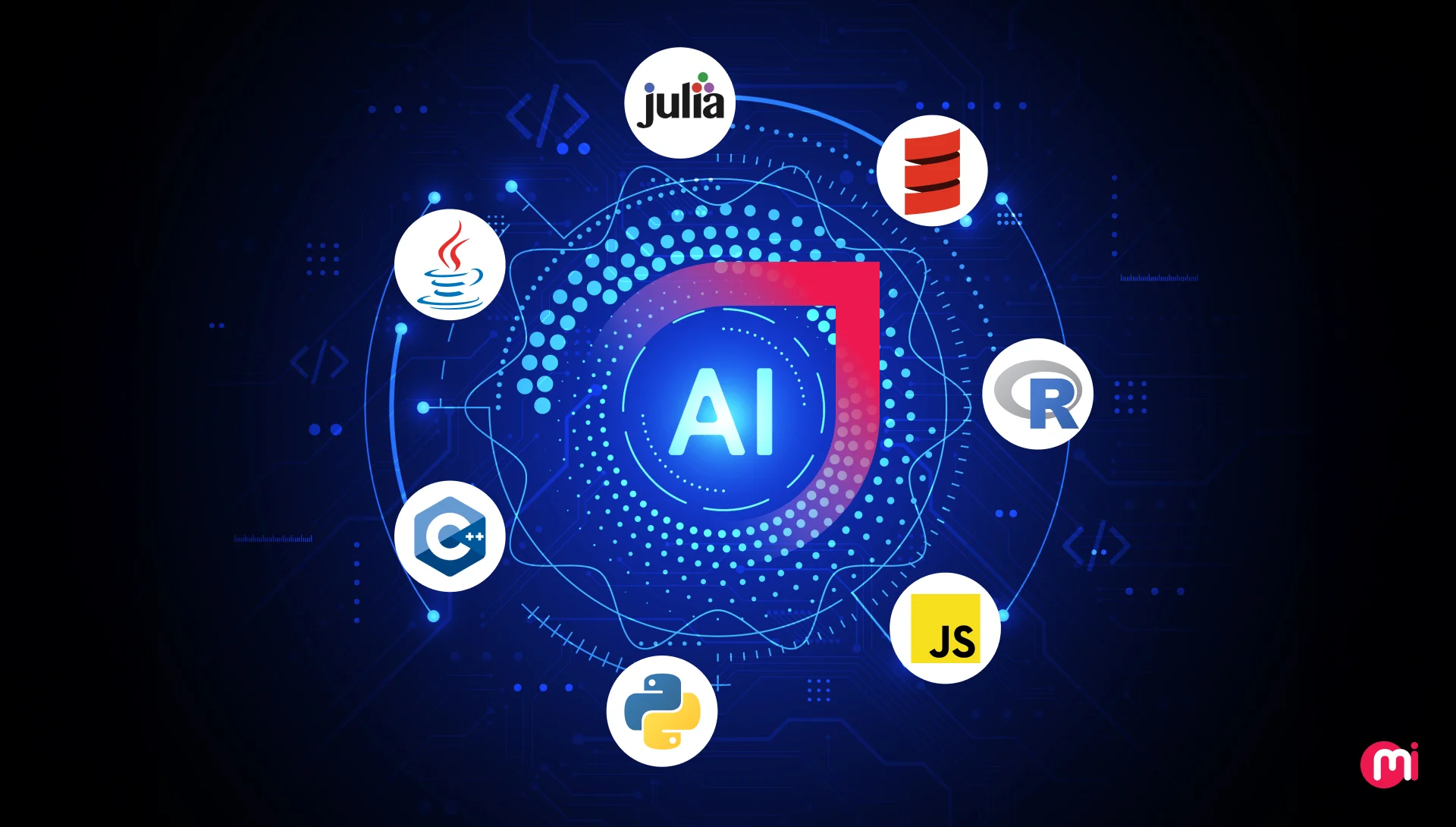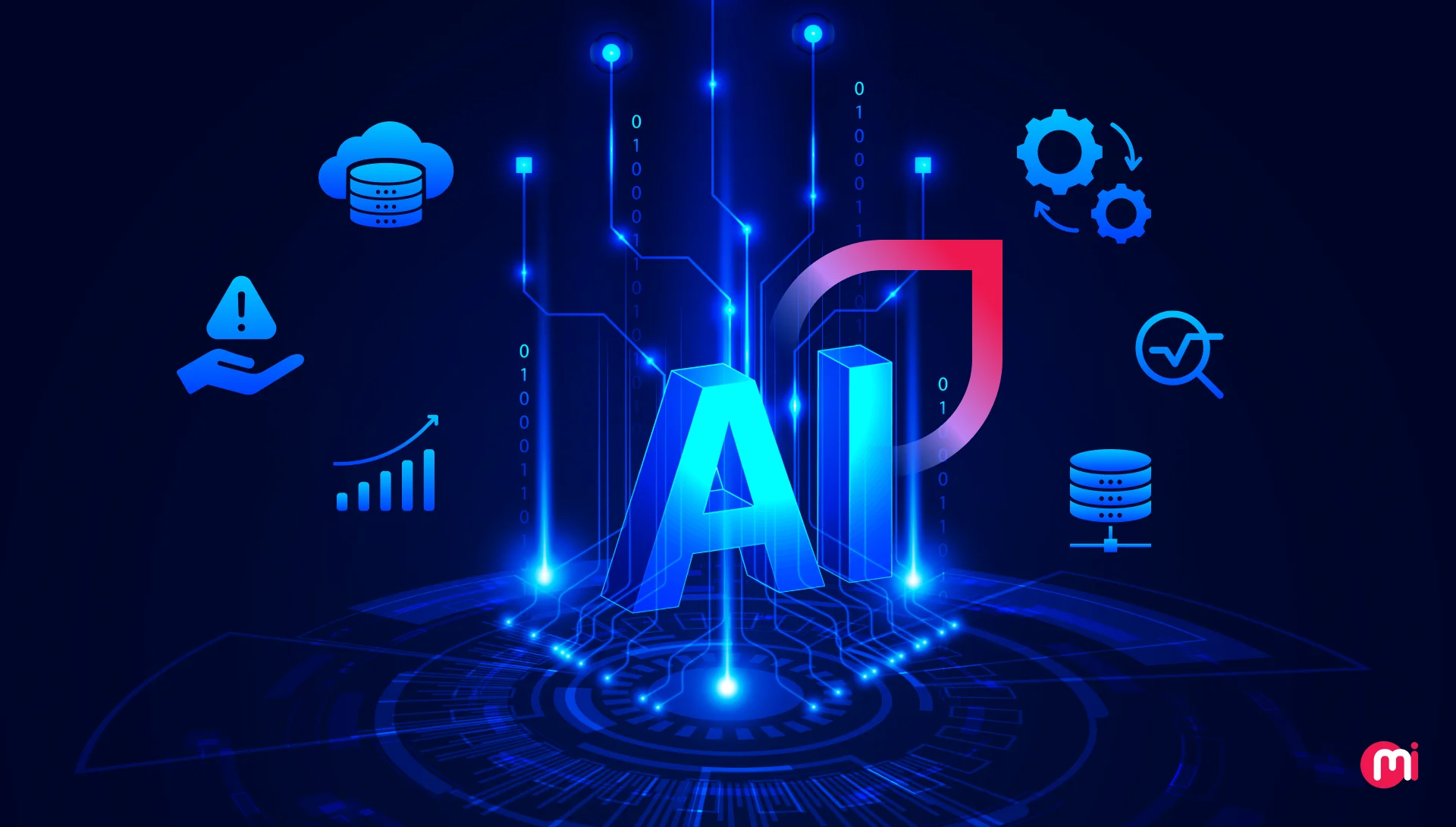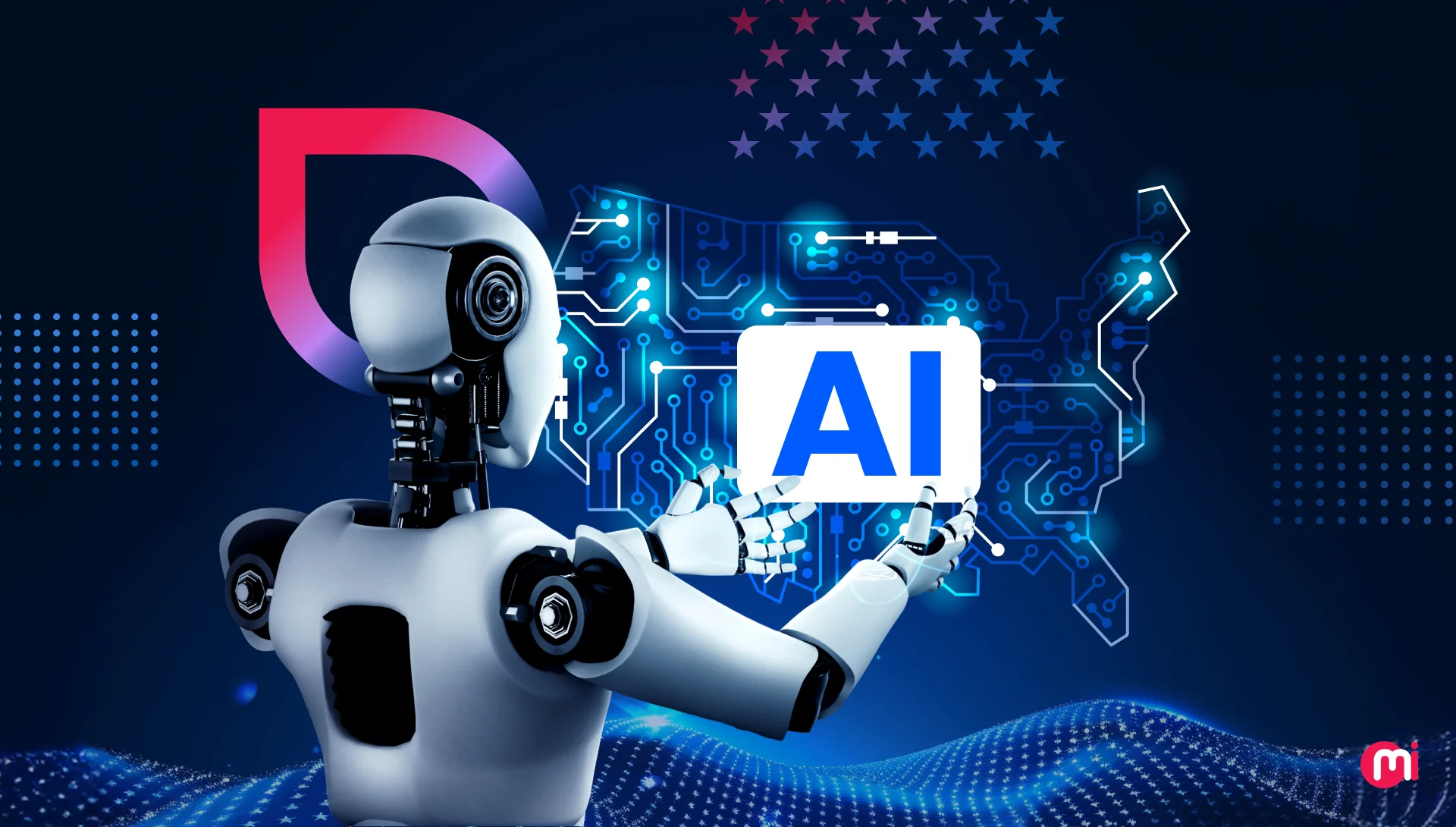What Are the Top AI Programming Languages?
- AI/ML
- October 17, 2025
With AI taking the world by storm, it is hard to overlook its existence in this 21st century of the digital era. Want to know what separates the hype from the reality? Well, the answer lies in its code. If you’re curious to understand why Python is the undisputed king in helping with automation, training machine learning algorithms. And, Java plays a crucial role in helping enterprises to gain more scalability than tag-along.
In this write-up, we will explore and learn about the top AI programming languages that are acting as building blocks of our intelligent future.
It goes without saying that artificial intelligence is no longer a stuff of science fiction. With more and more businesses opting for AI, it has become of utmost importance for everyone, not just AI developers, to get a hold of programming languages for AI.
According to research done by Statista, the market size of AI is expected to show an annual growth rate ( CAGR 2025- 2030 ) of 26.60%, resulting in a market volume of US$1.01 Tn by 2031.
According to research done by Grand Research View, the market size and forecast for AI in 2033 is expected to grow to USD 3497.26 billion.
According to research done by Fortune Business Insights, the global AI market size was valued at USD 233.46 billion in 2024, and is projected to grow from USD 294.16 billion in 2025 to USD 1771.62 billion by 2032, exhibiting a CAGR of 29.90% during the forecast period.
The numbers say it all, don’t they? So, from generating art platforms like Dall-E to life-saving medical advancements like DeepMind’s protein structure predictions, AI is giving engines powering tangible breakthroughs. However, behind the curtain of the most iconic AI marvel lies the most critical choice: programming languages for AI development. That said, with a vast array of options, selecting the best programming languages can feel overwhelming. This write-up is designed to cut through the noise.
In this guide, we will provide you with an in-depth insight into the top AI programming languages to help you explore their unique strengths. Without further ado, let’s get started.

Understanding Programming Languages for AI
AI programming languages are general-purpose languages that possess specific features that make them highly effective for artificial intelligence tasks. These languages are built in a way that they simulate human intelligence.
They provide a foundation to create an algorithm that can analyze patterns, identify data, and make decisions. What sets the best programming languages for AI apart is their robust ecosystem of libraries and frameworks that are curated for complex data analysis, model building, and mathematical computation.
Simply put, these languages form the backbone of intelligent systems. They enable a programmer to feed instructions to a computer so that it can easily perceive, understand, and take the necessary actions.
For example, Python has gained massive popularity for libraries like Pytorch, and on the other hand, R is famous for statistical analysis.
Top AI Programming Languages
To make the most out of artificial intelligence, it is of utmost importance to understand the programming languages that make it paramount. Now, let’s dive into the best programming languages for AI that are driving innovation today.

1. Python
It is impossible to get started with the list of top AI programming languages without Python. Python has established itself as the lingua franca of the AI community. Its readable and clean syntax cuts down the barrier to entry, making it one of the most favourite choices for beginners, while remaining powerful for complex and enterprise-grade AI and ML development services.
The true power of Python lies in its extensive set of specialized libraries. Frameworks like PyTorch and TensorFlow have become the industry standard for building and creating neural networks. On the other hand, libraries like Scikit-learn provide a comprehensive set of toolkits for traditional machine learning tasks. The rich ecosystem of Python has enhanced the entire AI in software development lifecycle. From data preprocessing with Pandas to model deployment, it has got you covered for everything. This utility and uniqueness of Python is the core reason as to why many businesses partner with a Python development company for a wide range of projects.
Key Strengths of Python
- Quick Prototyping: The simple syntax of Python enables quick experimentation and iteration.
- Massive Library Support: It provides access to a large array of pre-built tools for deep learning, machine learning, and data science.
- Vibrant Community: With an active and enormously big global community, Python always has robust support, shared knowledge, and tutorials.
- Flexibility: It has excellent integration capabilities with other languages and platforms.
Common Applications
The driving force behind the wide spectrum of AI applications is Python. From natural language processing (NLP) in sentiment analysis tools to computer vision in facial recognition systems, Python is used for everything.
It is one of the most dominating languages for research, data analytics, and the creation of top-notch, sophisticated Generative AI solutions.
Top Python Packages and Libraries
- Numpy: The fundamental library for scientific computing, and handling complex mathematical structures effortlessly.
- pandas: It is an essential library for analysis and data manipulation. It offers fast and flexible data structures like DataFrame.
- Matplotlib: It is a comprehensive library to craft a huge variety of animated, static, and interactive data visualizations.
- scikit-learn: It is a versatile machine learning library that provides simple and efficient tools for data mining, classification, and regression tasks.
2. R
R comes out from the world of statistics. While Python acts as a generalist, R acts like a specialist by offering an environment that is specifically made for statistical analysis, exploratory data modeling, and data visualization.
Simply put, R is one of the best programming languages for AI, especially when it comes to stats. The ecosystem of R is designed for data scientists and statisticians. Its tools like ggplot2 that allow for the creation of intricate and publication-quality data visualisations.
Key Strengths of R
- Statistical Core and Depth: R comes with unmatched built-in capabilities for statistical analysis and computing.
- Best Visualisation: It offers tools for crafting complex and insightful data visualisation.
- Niche Packages: It comes with a rich repository of packages for specific fields like econometrics and bioinformatics.
Common Applications
R is mostly used in academic research, financial modelling, clinical trials, and AI applications that are grounded in a rigorous statistical interface.
R is known to excel at different tasks like time-series forecasting, survival analysis, and crafting in-depth analytical reports.
Top R Packages and Libraries
- ggplot2: It is one of the most advanced data visualisation packages for statistical programming. It breaks down graphs into semantic components such as layers and scales.
- dplyr: It is one of the core packages of R. Its set of functions is designed to enable dataframe manipulation in a user-friendly and intuitive way.
- Tidyr: It is another package used solely for tidying and reshaping data. It helps in converting data in long and wide formats, analyzes, and handles the missing components efficiently.
- Plotly: It is a package to craft interactive graphs and charts that are ready for publication.

3. Java
Java is consistently used in AI to develop sophisticated software applications. Its reputation for scalability, stability, and security makes it fundamental for enterprise-level AI. The robust ecosystem of Java integrates powerful AI libraries, such as Deeplearning4j, for building neural networks and Weka, for machine learning tasks.
The strong memory management and its multi-threading capabilities make it one of the best choices for building systems that need to handle large volumes of data and concurrent user requests. As a leading AI development company, we often notice that Java is chosen for large-scale systems where reliability is paramount.
Furthermore, the “write-once, run everywhere” philosophy of the Java Virtual Machine (JVM) ensures the deployment of AI applications consistently across diverse corporate environments.
Key Strengths of Java
- Platform Independence: The aspect of seamless deployment comes with the JVM across different servers and operating systems.
- Scalability: Java is considered one of the most suitable AI programming languages for building large and distributed systems.
- Mature Ecosystem: It acts as a wealth of well-documented libraries, enterprise support, and tools.
- Security: The strong security features that come along with it make it ideal for sensitive applications like fraud detection.
Common Applications
Java is mostly used in building enterprise search engines, large-scale fraud detection systems, network security tools, and recommendation systems integrated into e-commerce platforms. Simply put, it is one of the foundational programming languages for AI in the corporate world.
Top Java Packages and Libraries
- Google Guava: It is an open-source set of core Java libraries. It offers powerful and flexible in-memory caching mechanisms. Moreover provides primitive support for working with primitive types.
- Log4j 2: It is an open-source logging framework for Java applications. It provides significant improvements in performance, flexibility, and features.
- Google Web Toolkit (GWT): It is an open-source development toolkit for building and optimizing complex browser-based applications.
- Apache Struts: Another open-source framework for building enterprise-level Java web applications, based on Model-View-Controller (MVC) architecture.
4. C++
With raw speed as its top-most priority, C++ is the undisputed king of AI programming languages. Its ability to offer direct hardware access and low-level memory management makes it the only choice for applications where every microsecond counts.
From real-time systems and robotics to high-performance computing, C++ provides the fastest execution speed, making it one of the best choices for performance-critical AI applications.
The level of control that comes with C++ makes it one of the most ideal languages for building the core engines of real-time systems.
Key Strengths of C++
- Unmatched Performance: It comes with the fastest execution speed for easily computing intensive tasks.
- Resource Control: C++ comes with finest finest-grained control over memory and system resources.
- Hardware Optimization: It offers the ability to write code that is highly optimized for specific hardware architectures.
Common Applications
C++ acts as one of the core backbones, especially when it comes to performance-critical AI systems. It is extensively used in robotics, autonomous vehicles, high-frequency trading algorithms, and AI video games. Furthermore, it is a go-to language for developing embedded AI systems that run on resource-constrained devices.
Top C++ Packages and Libraries
- OpenCV: It is a well-known C++ library. It is mainly used for real-time computer vision, image processing, and machine learning tasks.
- Boost: Another popular set of libraries in C++. It provides unwavering support for complex tasks and structures such as linear algebra, pseudorandom number generation.
- Cinder: It is a free and open-source library for professional-quality creative coding in C++. It takes care of various domains like audio, graphics, and computational geometry.

5. Julia
As an exciting and modern language, Julia is designed to offer the best of both worlds. Wondering what worlds we are referring to? Well, we are talking about the user-friendly syntax of Python and the raw speed of C.
Julia was crafted from the ground up for high-performance numerical and scientific computing, thus making it a natural fit for computationally demanding AI tasks. The growing popularity of Julia is one of the key AI trends to watch.
Key Strengths of Julia
- High Performance: With the help of Julia, you’ll end up singing up for exceptional speed due to Just-In-Time (JIT) compilation.
- Parallel Computing: It provides ultimate native support for parallel and distributed computing.
- Interoperability: It offers seamless interaction with code written in other programming languages. This helps in leveraging existing libraries and integrating Julia into diverse software ecosystems.
Common Applications
The most common applications of Julia include scientific data research, machine learning research, and financial modelling. Furthermore, it is one of the most preferred choices for high-performance computing applications.
Top Julia Packages and Libraries
- Flux.jl: It is an open-source machine learning software library. It allows a minimal footprint while delivering a strong feature set and easy syntax.
- Scikit-learn: It is a free and open source machine learning library for the Python programming language, and one of the simplest tools used for predictive data analysis.
- DifferentialEquations.jl: It is a high-performance and comprehensive suite for numerically solving a wide range of differential equations in scientific computing.
6. JavaScript
When it comes down to seamless end-to-end AI integration on a web platform, JavaScript plays a crucial role. It simply enables AI applications through familiar web programming. It has gained popularity for full-stack development and integrating AI features into website interactions.
It makes use of an event driven model to handle the inputs of the users and update pages without lag. Simply put, it has profound implications for AI in mobile app development and web applications.
Key Strengths of JavaScript
- Unmatched Speed: Being an interpreted language, it cuts down the time needed for compilation in other languages like Java. Moreover, it is a client-side script that shortens the time required to establish a server connection.
- Rich Interface: It offers developers a variety of interfaces to create engaging websites. Plus, it enables real-time AI-powered user experiences.
- Interoperability: It seamlessly integrates with other programming languages. That said, most developers favor using it to create various applications.
Common Applications
JavaScript is mostly used to build interactive web demos, object detection, and real-time image processing in the browser, and AI-powered features in web applications. It also plays an essential role in building responsive, conversational interfaces that power modern chatbots and virtual assistants.
This capability of JavaScript makes it a critical language for companies that offer custom AI agent development services, thus allowing them to build an intuitive front-end through which users interact.
Top JavaScript Packages and Libraries
- React.js: It is an open-source front-end JavaScript library. React.js is the second most widely used web framework. Big giants like Netflix, Grammarly, Outlook, and Trello, and more use React.js because of the exceptional features like high-performance, virtual DOM, debugging, and much more that it offers.
- Vue.js: As one of the versatile JavaScript frameworks, it is less complex. It offers HTML-based templates, CSS transitions and animations, with better adaptability.
7. Scala
Scala runs on JVM, combining the best of object-oriented and functional programming. Its tight integration with Apache Spark has helped it to become a dominating language in the big data ecosystem.
For enterprises dealing with massive datasets, Scala acts as one of the top programming languages for AI development. If you are looking forward to developing or managing high-powered AI applications, mastering Scala could add a feather in your cap.
Key Strengths of Scala
- Big Data Integration: With the rise of big data, businesses are looking for a powerful tool to process and analyze large datasets. This is where Scala truly shines.
- Scalability: It supports both large and small script systems, making it an ideal choice for applications that need to grow and evolve. The language can handle high loads without compromising its performance.
- Rich Ecosystem: It includes a wide range of libraries and frameworks to enhance productivity, thus providing developers with robust solutions for various use cases.
Common Applications
Scala is widely used for building large-scale machine learning pipelines, distributed data processing systems, and real-time data analytics platforms.
Top Scala Packages and Libraries
- Apache Spark: As an open source unified analytics engine for large-scale data processing, it provides an interface for programming clusters.
- Akka: It is a high-performance toolkit for high-load systems and low-level interfaces. It helps in building highly concurrent and resilient message-driven applications with the help of the actor model.
- Play Framework: It is a highly productive web framework, which is designed to build modern, scalable web applications on the Java Virtual Machine.
Comparison of Best AI Programming Languages
Making the choice from many programming languages for AI is a crucial decision that could impact everything from development timeframe to final results. That said, let us now take you through the chart below to help you make the right choice.
| Language | Primary Strength | Learning Curve | Best For |
| Python | Versatility & Ecosystem | Easy | Prototyping, General AI |
| R | Statistical Depth | Moderate | Data Analysis, Research |
| Java | Enterprise Stability | Moderate | Large Scale Production Systems |
| C++ | Raw Performance | Hard | Real-Time & Embedded Systems |
| Julia | Speed and Simplicity | Moderate | Scientific Computing & Research |
| JavaScript | Web Integration | Easy | Client Side and Interactive AI |
| Scala | Big Data Processing | Hard | Distributed ML Pipelines |
Summary
Choosing the right AI programming language is the most crucial step in any successful AI project. While versatility and vast libraries of Python make it one of the most ideal choices for most applications, specialized tasks require different tools.
High-performance systems rely on languages like C++, enterprise-level often turn to Java, and large-scale data analysis makes the most out of the statistical powers of R.
It goes without saying that the landscape of AI is dynamic and understanding, plus the strength of each language is the key. That said, by making strategic choices and partnering with an expert AI development company, you can build innovative, efficient, and future-proof solutions that harness the true power of artificial intelligence.
Partner with us and make the most out of AI programming languages. Whether you are looking to hire an AI developer or looking for AI, ML development services, MindInventory is your trusted partner.
FAQs
Python is the most popular and user-friendly AI programming language. Its clear syntax and wide range of packages and libraries makes it stand out more than others.
Python is mostly crowned as one of the best languages for AI. With its dominance in AI and ML space, it is clean, intuitive and promotes readability and reduces the learning curve for someone who is new.
Python is considered as an AI programming language for beginners in AI. With its extensive collection of libraries, it allows beginners to start experimenting with AI models quickly.
It goes without saying that Python excels in its flexibility and simplicity, thus making it one of the most preferred choices for several AI projects. However, the scalability, robustness and performance of Java also makes it a great choice for enterprise level applications.
C++ is considered the speed demon for performance centric AI.













